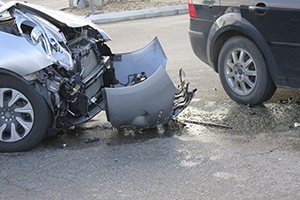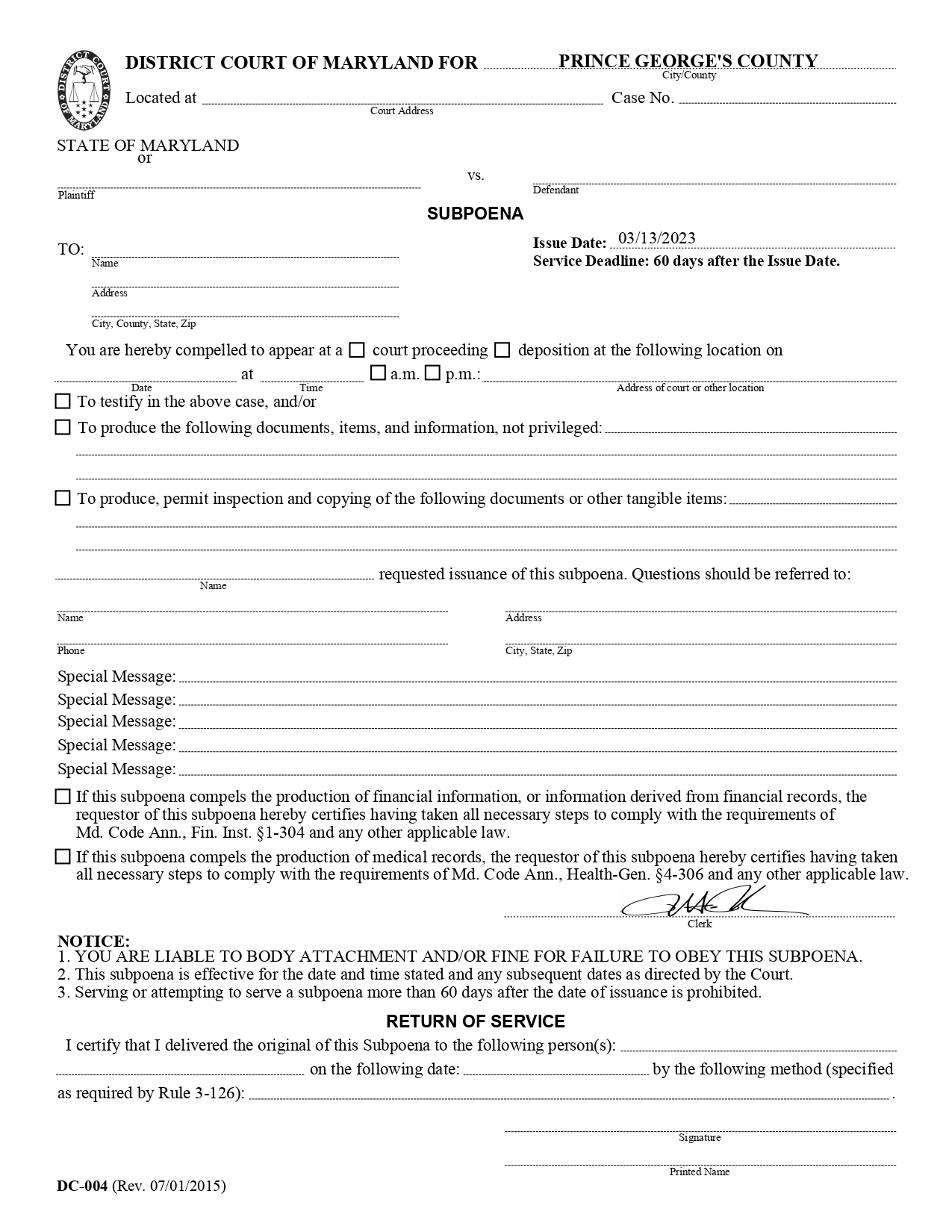
In our previous article, we discussed the overall make up of the Maryland Court System, and how every county has two courts: a District Court and a Circuit Court. The District Court is the lower-level Court, and can hear lawsuits where the demanded amount is $30,000 or less. We explained how, in some car accident cases, this is the preferred option, as it can be quicker and less expensive.
In that article, we covered bringing the lawsuit itself, including how to file the suit, and how to get it served. In this article, we will cover the rest of the Court process, including trial itself!
Discovery
Here is one major difference between the General District Courts of Virginia and the District Courts of Maryland: in Maryland litigants can do some discovery! Discovery is a court process where each side tries to get information on the positions and contentions of the other (or others, if there are multiple parties).
Discovery is often used to get the answers to very specific questions:
- Who are the witnesses in this case?
- What are your contentions?
- What are the facts on which you are basing your allegations (or defenses)?
- How did the accident happen?
- Do you have any documents (relating to certain points, incidents, and positions).
- and more
Discovery in Circuit Court includes four primary mechanisms: Interrogatories, Requests for Production, Requests for Admissions, and Depositions. In District Court, only Interrogatories are available.
Interrogatories
District Court Interrogatories are governed by Maryland Rule 3-421. Interrogatories can be used to gathering and discover any information that is discoverable – which is distinct from admissible. Discovery is often interpreted rather broadly, so even if something cannot be discussed in open court, it may be still be a legitimate question in the discovery process.
Interrogatories are limited to a grand total of 15 questions (3-421(b))!
A party receiving Interrogatories has only 15 days to respond – but be warned, this does not mean that you have 15 days to get your answers back to your attorney! The 15 day response time can be problematic, because your attorney not only has to get your answers, but he has to re-format them into an official discovery document, and he has to pose objections. At Blaszkow Legal, when we received District Court interrogatories directed at our client, we turn them around immediately, and send them to our clients. We need those answers back in 5-7 days, so we can begin crafting our objections, and exploring the answers with our client.
Objections – objections can be made on numerous grounds to interrogatories, because the question may be improper, for a variety of reasons. Some of the most common objections include an objection when:
The Interrogatory is vague, overbroad, burdensome and oppressive. For example: “List every gay station you have ever gotten gas from by name and address, since 1975.”
The Interrogatory seeks improper inquiry into the work product, trial strategy, and mental impressions of counsel.
The Interrogatory seeks information that is irrelevant to the matters at issue in this litigation.
Objections can be posed, and the questions still responded to – attorneys will do this to preserve the objection in the event of appeal, or if the other side attempts to use objectionable material at trial. Alternately, an attorney may decide to “stand” on the objection, meaning that no answer will be forthcoming.
Subpoenas
Attorneys in Maryland can issue subpoenas for information, documents, and tangible things. Subpoenas are official court documents that can be served by private process server, or the Sheriff. Subpoenas can be sent to non-parties, or people who are not participating in the trial itself.
Subpoenas are often used to obtain medical records, billing information, lost wage documentation, financial records, police reports and videos, and more.
Attorneys can generate attorney-issued subpoenas, called a Subpoena Duces Tecum through the state’s AIS system. A non-represented party would have to request the subpoena from the clerk’s office and the clerk would issue the subpoena.
Subpoenas can, of course, be objected to, and people can move to quash them (or have them dismissed).
Motions
Motions are not terribly common in the District Courts of Maryland, but they do happen and there is a procedure for it. In Maryland car accident cases, the most common motion is a Motion to Compel Discovery. For example, if the Defendant fails to respond to the Plaintiff’s Interrogatories, then the Plaintiff’s attorney may move to have the Defendant compelled, or forced, to answer.
A party ignores a motion at its own peril, because there are penalties for failing to respond to a motion. Firstly, without an opposition, there is a likelihood that whatever the movant (person bringing the motion) requests, they will get. Also, a judge can penalize a litigant for failing to respond: some judges will assess a monetary award for attorneys fees, and others will grant the dismissal of a case (often sought by the defense) or the waiver of certain defenses (when brought by a Plaintiff).
A litigant has only 15 days to respond after a Motion is filed.
The District Court Trial
Trial is heard in the District Court by “the Bench,” meaning that a Judge will hear the case. Juries are only empanelled in Circuit Court. So the Plaintiff will have to convince a Judge of the merits of his or her case, while a Defendant will be attacking the Plaintiff’s case before same.
Even when it is before a Judge, a trial can still be daunting to many people. This is why it is so important to have an attorney who is not afraid to take a case all the way to trial.
How Maryland District Court Trials Work
Opening Statements
Opening statements are made by both parties, with the Plaintiff going first. This is often a short recitation of the case, with then a brief argument about what the merits of this claim or that claim. The Defense goes next, and will state its case, and will usually dismiss claims or assert defenses as they see fit.
Putting on Your Case
The Plaintiff presents his case first. The Plaintiff’s attorney will call witnesses and introduce evidence as necessary to build the case, and make the best arguments possible. In the realm of a car accident case, this means proving that the accident happened, and was the fault of the other driver. Once this has been established, the Plaintiff’s lawyer will then begin to illustrate the Plaintiff’s damages: how he was hurt, how he was impacted, what the treatment consisted of, and how his life was impaired and interrupted by the crash.
Evidence at this stage includes medical records, itemized bills, property damage pictures, videos, and sometimes pictures of specific injuries such as cuts, bruises, and surgery marks/scars.
Witnesses
The Plaintiff will call witnesses, and so will the Defense. The calling attorney will question the witness, called direct examination. Then, the other side’s attorney will be able to conduct a cross examination, or asking their own set of questions. On some occasions, though rare, the calling attorney may ask for a re-direct, which seeks to clarify or narrow down a point made during the cross examination.
Closing Statements
At the close of the evidence, each side will make a closing statement, or a synopsis of all that has been said. The Plaintiff will ask the Court to award whatever monetary damages they seek, and the Defense will argue that nothing has been proved, and no award should be made.
Verdict
The Court – meaning the Judge – will sometimes rule from the Bench, having considered everything carefully. Sometimes, the Judge will not rule immediately, and will instead notify the parties of his or her decision. The Court is not restricted by what the parties ask for: for instance, if the Plaintiff asked for $30,000 in damages, the Court may only have found 2 of 4 emergency room visits as related to the accident, and so decides to award $15,000 in damages.
Appeals
After a Judgment has been rendered by the Court, the litigants have 30 days to file an appeal. This appeal goes before the Circuit Court of the county where the trial happened – so if the Montgomery County District Court heard the case, the appeal will be heard in the Montgomery County Circuit Court.
The District Court Lawsuit – from Beginning to End
Lawsuits can be very intimidating, even for “smaller” amounts of money. There are a whole host of rules and quirks of court procedure that have to be obeyed, or a person can lose their case.
If you have any questions about the Maryland District Court process, don’t hesitate to call a law firm where our lawyers fight for our clients in every court in the state! Blaszkow Legal – 703-879-5910



